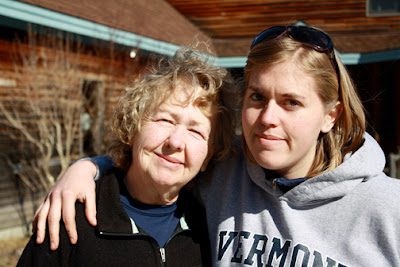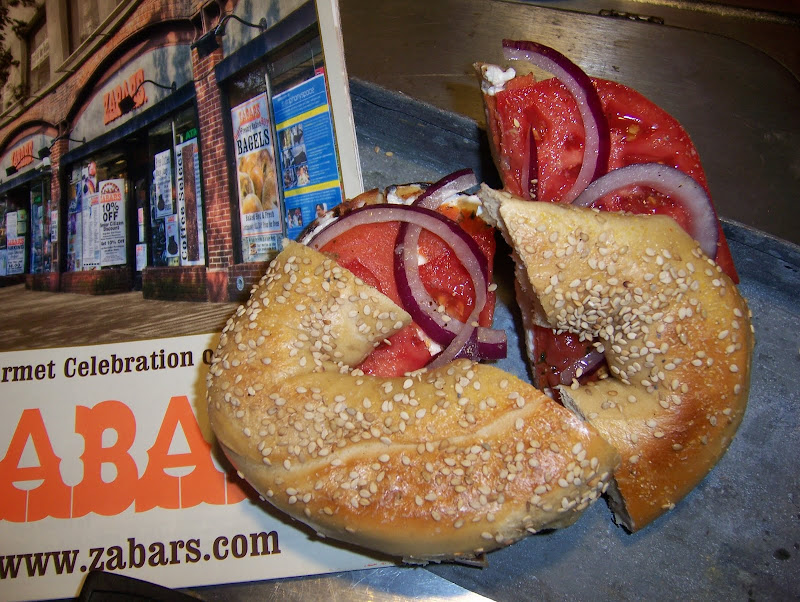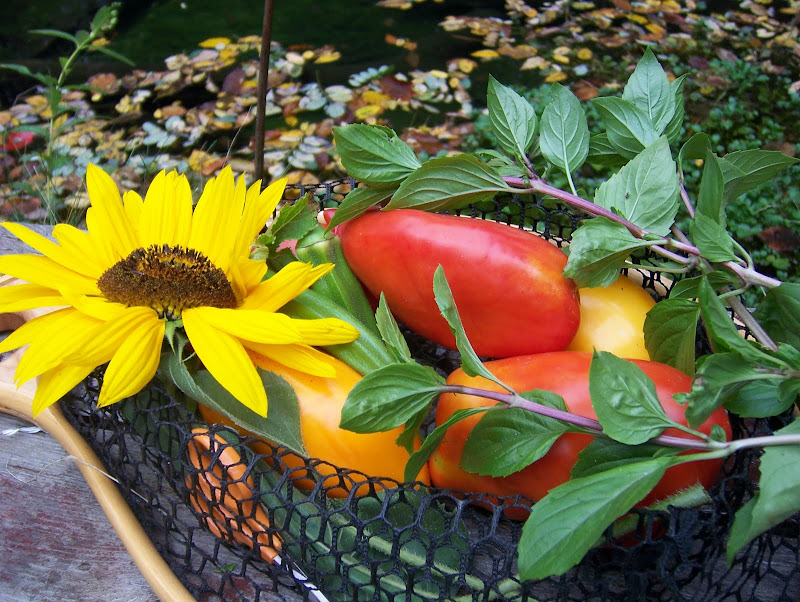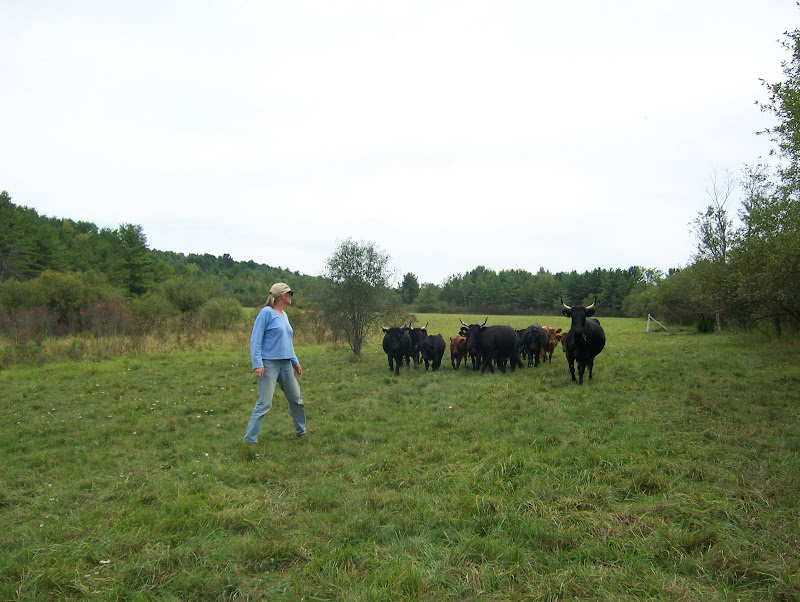There’s nothing like taking a ride in this season when the color is coming on and the days are high and blue and breezy, and so, a few days ago, I drove up northwest of Brandon to
Spotted Dog Farm. Once there, I surveyed the vistas and spied not one cow. In fact, I’d been talking to Susan and Chic Whiting for a good half hour and the only animal I’d encountered was the enthusiastic and eponymous spotted dog, himself named Hawk, and a spotted pony that we were leading down to a corral. Oh, the registered Irish Dexter Cattle were off in a field (a breezy wave of the hand), said Susan, but I was beginning to doubt it. This wasn’t Montana, for instance, where a beeve could wander miles in its quest for grass.
But darned near it! There were 35 or so head of those diminutive cattle on 185 acres, and they were clear and way back on the back forty. Finally some black- and cinnamon-colored dots began to detach themselves from the rising treeline of one field and, like a wave, rushed the length of the field, stopping in a clump five feet away from us, heads down, necks stretched, their round nostrils whiffing and blowing bubbles, half-masticated clumps of grass sticking out the sides of their faces. These were the yearlings, half a dozen of them or so, sequestered from the mammas and babies so they might begin to learn to wear a halter and come when called.
Susan and Chic see their operation ultimately with three aims – cattle for beef, milk, and burden. At this point the meat operation is in full swing – they are able to sell the beef from six of the animals a year at the Rutland Farmers’ Market, and soon will sell from their farm store, too.
As for milking them – that’s in the future for now, and Chic and Susan doubt they’ll milk for themselves, but will raise the cows to sell for milk. And for burden. For these little cows are gentle, smart, and trainable, and can be used in pairs as farm-teams to do farm work. They will eventually – beginning with these six – be halter-trained, and sold for this purpose, too.
A person or two could own one or two of these little cows and have their own – very creamy – milk, a team, if two, to help pull up stumps or do other farm work, and, eventually, with careful breeding, beef to eat. Gee whiz, and Gee Haw.
The little cattle – boxy like angus or Hereford, but slightly smaller than the Jersey, to my eye – are fully grass-fed, grazing rotationally all the time grass grows green, and eating that grass in the form of hay in the winter, during which they retain the freedom to roam about and snuffle out what winter fodder they might, yet with the option of the open-sided barn for protection against the elements. They have their treats, too, which consist of beet pulp, the stuff that is left after beets are crushed and wrung for their sugar, then dried and compressed. They also love alfalfa squares, and apples from the many apple trees on the property.
We walked back up to the house and I sat on the porch to make some notes.
The Whitings have been here since 2001, with the first of the Irish Dexters, living in a small trailer until their house was hauled up the road in three parts. It’s a pretty house – cape on one side and ranch – with that long porch – on the other, perched on a high gentle rise. There’s a view of the Adirondacks and the acres are hilly, and were overgrown until they began the process of pulling out the Buckthorne that had taken over. What had been 300 acres belonging to the Vermont Land Trust, had been divided into two pieces. It hadn’t been farmed in maybe fifty years and, when it had been, it was a dairy farm.
Working with the Vermont Land Trust has been invaluable to them, a liaison visiting once or twice a year to help keep them in compliance with Land Trust rules and regulations and to offer other kinds of help. It was he who connected them with Diane Heleba at the USDA office in Rutland. Sally Eugair, from the same office, helped them with a Wildlife Habitat Incentive Program (WHIP), to bolster up some areas and protect the wetland. EQUIP helped them deal with water quality. Cindy Watrous, from USDA, helped with a cattle nutritional program through a class that Susan took in Middlebury. And Willie Gibson and the Vermont Farm Viability Enhancement Program helped them produce a business plan.
“Networking is what it’s all about,” Susan says.
These names come as easily from their lips as from those of many other farmers I’ve talked to, because these people and agencies have been generous and helpful with their knowledge. And with that help, Chic and Susan have done an incredible job with infrastructure – water lines, barns, and berming of the land into paddocks – and growing a healthy herd.
“Wanna take the (John Deere) Gator and go find the main herd?” Chic asks, and I say an emphatic YES, having feared I’d taken up too much of their time already.
Well, shades of being 12 again. It’s been many many years since I’ve been on a tractor, and this little vehicle is much like one, though it has two seats and a small truck bed. Chic drives, I ride shotgun, and Susan is in the back. She slides off to open the many gates and close them behind us.
We wind up tippy, crooked little paths, around hills, down the farm path, all the way to the back of the farm, and there we find the main herd as we stop at one end of the field. After eyeing us quizzically from afar, the herd thunders bellowing to us down the length of the field. Some of them have wide and wickedly pointed horns. Those I do not approach, though I mix with some of the hornless mommas and babies.
Then Chic turns the Gator around and leads them out of that grazed paddock up to a nearer ungrazed one. It’s a slow start – they stand watching us at first but then notice that the gate is open and Susan and Chic are calling them and they suddenly thunder after us. It’s a wild race, the little truck with a slight lead as wild-eyed, wickedly horned beasts pursue us through the brush. Susan points out the hilly patches that they’ve cleared of buckthorn and other invasives. That’s a nice job, I say, imagining the challenge of it and long days spent outside doing this work. “It’s a good winter job,” says Susan. It’s the kind of job, I know, that beaches you in the evening in front of a fire and crock-potted stew, feeling immense gratitude at having done real, hard, grown-up work!
The cattle are now contentedly grazing on the new grass, Susan fastens the gate behind us and we return to the house.
My friend, Ann Tiplady, from Red Houses Farm in Wallingford, constantly raises the issue, “Can one make a living raising beef cattle? And if one can’t, should one be occupying oneself in this manner?”
And so I ask the Whitings if they can make a living off this way of life.
“No,” is the answer to that. A rueful “no.” Susan works as a Physical Therapist at the Rutland Hospital, and Chic, a retired policeman from the Hyannis Port area, drove a school bus for several years after moving here but now works fulltime on the farm. He tells me that it is the prevailing wisdom that you’d need 300 head to make a living from it, and that would require a farm several times the size, and then, of course, it becomes a chore. But that number would be for a regular commercial herd. The Whitings rely on ‘value added’ to make a profit, and that value added for them is that their cattle are grass-fed and tri-purposed.
My next, and last question: Do you love this life? Would you do it again?
The answer is instantaneous: “Absolutely!”
I take my leave, thanking them for the time they’ve taken out of their busy day to show me their impressive operation. Susan says, thoughtfully, “It’s good to take a little time, good to answer questions, because it makes us think about them. Usually we’re so busy we just keep on keepin’ on. Good to stop and think about why we’re doing what we’re doing.”
***
The Whitings welcome visitors but ask that you call ahead (247-6076). Spotted Dog Farm is a regular stop for the Audubon Society and popular with individual groups of birdwatchers. I can only imagine what a gold and glorious spot it will be in a few weeks.
Post Script: After this column was published in the
Herald, a letter was appended to the column with some thoughts on cows and horns. This is it:
Not to worry about the horns on those little cows. Dexters are very friendly. But... if the animal wanted to hurt you.... horns would be the least of your worries! They can all kill you with very little trouble, if they wanted to. I watch my cattle & they don't use their horns to fight w/ each other. They head butt.
Dexters have an extreme amount of vasiclature in their horns. Like an elephants ears, they dissipate heat, to keep the cattle cool. I have a few cows that came to my farm w/ their horns removed. Poor things suffer terribly during heat spells.
Addenda: 10/12/10
Sue checked out this information and got this reply from
Animal Welfare Approved:
Horns for thermo-regulation
There is potential for sheep, goats, cattle and bison to use their horns as part of their thermoregulatory (temperature regulating) processes. In cattle the extreme is the Ankole Watusi , a cattle breed native to Africa which has horns that can grow up to six feet long, honeycombed with blood vessels. This makes perfect sense as the Ankole Watsui evolved to live in areas where the temperature stays very high all year round.
The way the heat exchange process works is for blood to be pumped round the ‘core’ of the horn – the bit that actually has blood vessels in it – and as this blood passes close to the outside of the horn heat can be lost to the atmosphere and cooler blood returns to the body of the animal.
However, other cattle breeds evolved to live in colder environments and there is a difference in horn morphology for cattle breeds from tropical and temperate zones. Research has shown that in temperate species the surface area of the vascularised inner core is reduced while the thickness of the outer keratin sheath is increased. This limits heat loss from the horns, as in colder climates loss of heat would be a welfare negative.
Animals have evolved to adapt to their environment but this adaptation takes many thousands of years. An animal from a hot climate cannot suddenly switch from using their horns to cool themselves to stopping that heat loss. It is worth noting that antelope originating from Africa have actually been found to have frostbite at the tips of their horns when they are kept in zoos in cold countries – the cooling effect of having horns cannot be controlled by the animal.
The Dexter is obviously a temperate cattle breed; originating from south west Ireland. Its horns will therefore not be a major part of its cooling process.
Further to the points above, thermoregulation in cattle is not solely a function of having horns. There are a number of breeds and strains of cattle that are polled – that is they naturally do not have horns. A number of popular cattle breeds such as the Angus are polled cattle and other widespread breeds such as the Hereford have polled strains. If the only way cattle could heat regulate was through their horns these animals would not look very healthy.
When temperatures exceed the thermo neutral zone for cattle – at around 85F or more – the animals regulate their temperature by evaporative cooling. Evaporative cooling is mainly effected through sweating and respiration. Heat stress is a function of time, temperature and humidity, because cattle rely on water evaporation via sweating and panting to dissipate an excess of heat they have generated metabolically or absorbed from the environment. High humidity makes evaporative cooling less efficient. Cattle will seek shade when it is available to minimize the effects of high temperatures.
There are negative points to having horns for the animals and for the stock people managing their health and welfare. Animals can damage one another with horns – a boss animal whether male or female will keep less dominant animals away from feed and water with its horns. Breeding males can fight and injure one another with their horns. In the wild this is about survival of the fittest and allowing younger animals with different genetics to take charge of the herd and breed. In a farming situation this could be the incapacity or loss of your best bull. Lastly there is a human health and safety issue with handling horned cattle. A horned steer that throws its head around when it is being handled can be a considerable danger to those trying to work with it.
There are some farmers who choose to keep horned cattle and who have the particular skills and equipment to manage them – for example feeders and squeeze chutes must be specially adapted for horned animals to prevent them being trapped or injured. AWA would never require that such farmers moved to breeding polled cattle or that they disbud their calves to stop horns growing. However AWA does recognize that for other farmers and other breeds disbudding calves may offer the best welfare for life. AWA does of course specify the age and methods of disbudding that are acceptable to minimize the stress of the operation. AWA does not allow the mutilation of dehorning – the removal of the horn once it is fully formed and attached to the skull.
References:
Picard K, Festa-Bianchet M, Thomas D (1996) The cost of horniness: heat loss may counter sexual selection for large horns in temperate bovids. In: Ecoscience 3(3): 280-284
http://countrystudies.us/united-states/weather/vermont/brandon.htm





















